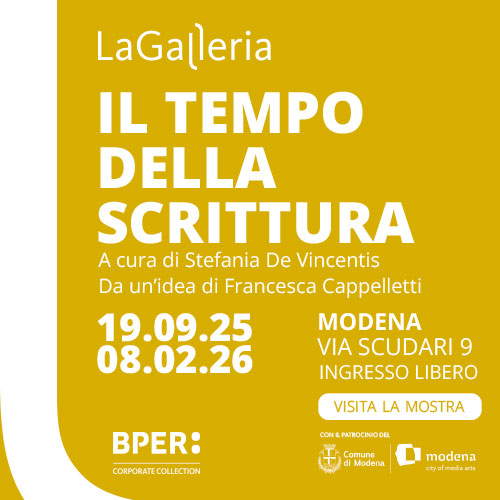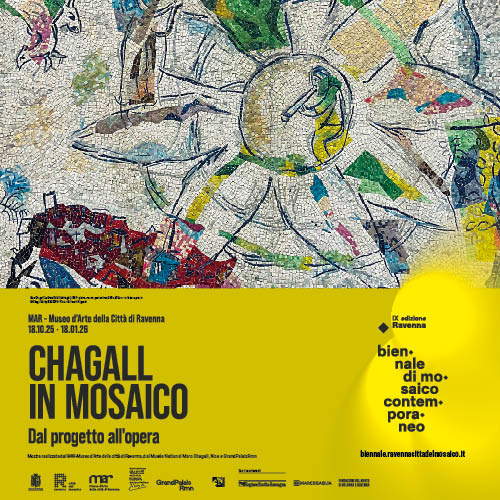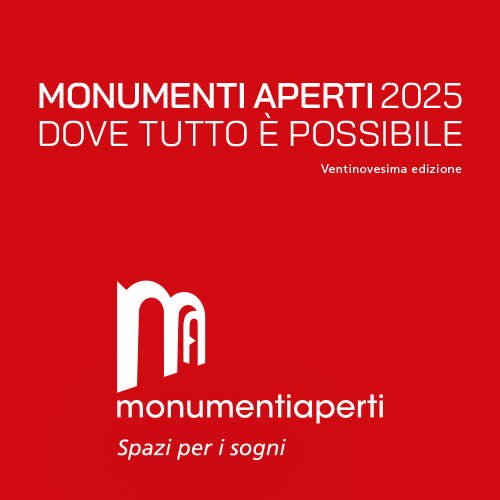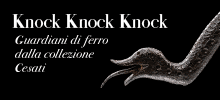
The animals of the Palio and where to find them: symbols and identity of the Contrade of Siena
From imperial eagles to crowned dolphins, the symbols of the seventeen Contrade tell a Siena of history, pride and belonging. A journey through coats of arms, baptismal fountains and district museums. Here is where you can find all the representations of the Palio animals scattered through the streets of Siena
By Noemi Capoccia | 07/11/2025 16:28
The Palio di Siena is one of the most fascinating and complex events in Italy, organized directly by the City of Siena. Every year, on July 2 and August 16, ten out of seventeen contrade run the historic competition and compete for the prestigious drappellone, a prestigious prize commonly called the "cencio" by the Sienese. The selection of the ten contrade that participate in the July Palio follows a precise criterion: in fact, the seven contrade that did not run the previous year's Palio participate, plus three drawn among the ten that did run.
But how old is the Palio? We do not actually know the precise date of its birth, just as we have no certainties about the founding of the city, which according to legend goes back to the sons of Remus, Senio and Aschio, who fled from Rome and even starred in a primordial Palio. We do know, however, that during the golden age of the Sienese Republic, from the thirteenth century until the mid-fourteenth century, the Palio was the solemn conclusion of the festivities dedicated to the Assumption. The horse races, which sometimes took place without a jockey, culminated with the arrival at the Cathedral and the handing over of the pallium, a cloth of precious fabric, forerunner of the modern drapery. With the Renaissance, the festivities took on new aspects, including ball games, bull hunts, and buffalo rides.
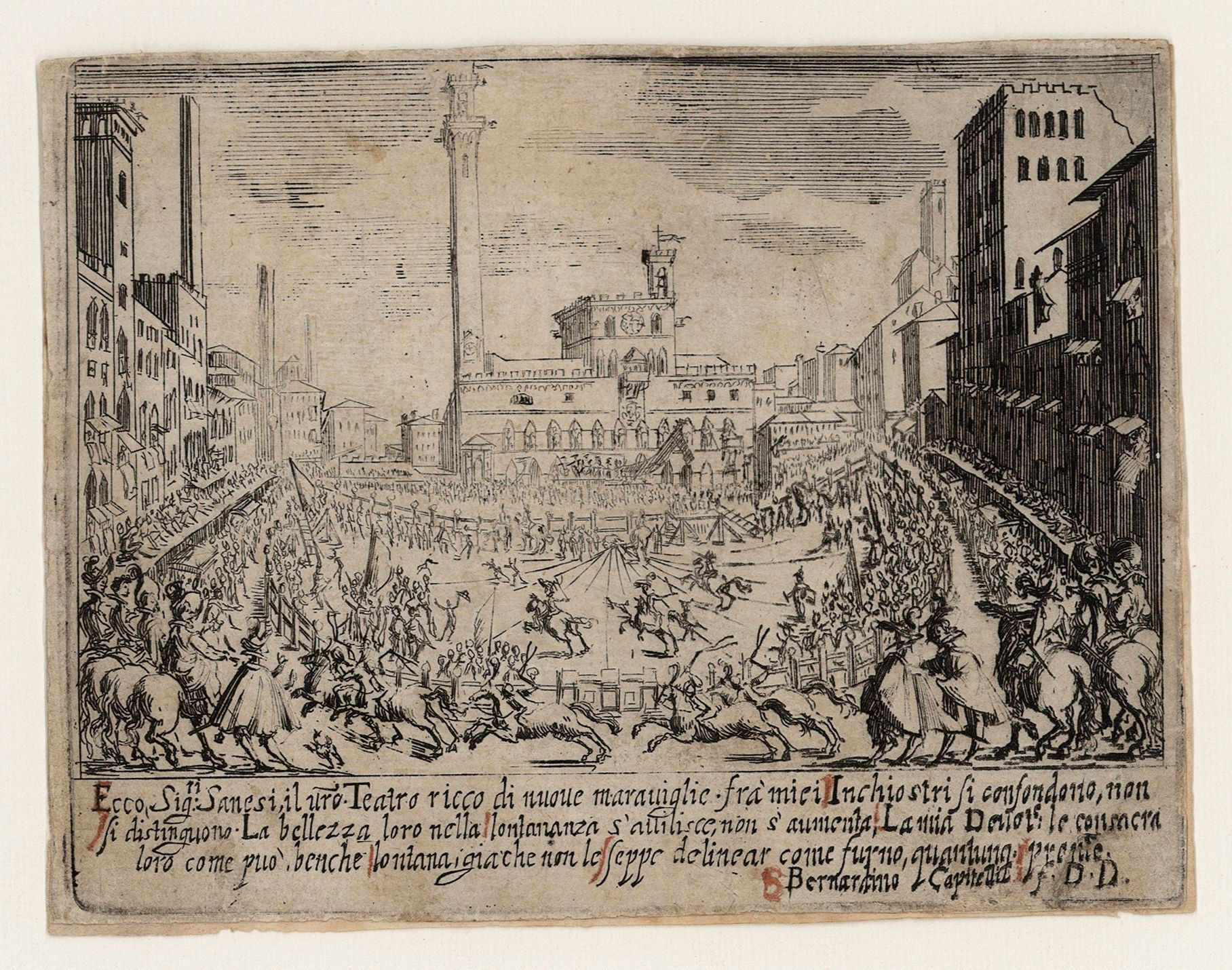
We also know that the present-day subdivision of the seventeen Contrade was sanctioned in 1729 by Governor Violante Beatrice of Bavaria with the Bando sui confini. In fact, since 1894, with the birth of the Magistrato delle Contrade, the contradaiole institutions have been committed to managing the Palio, while the Comitato Amici del Palio, founded in 1947, and later the Consorzio per la Tutela del Palio, established in 1981, have ensured the promotion and safeguarding of the festival. The contrade (already present since the 15th century), then chose animals that we might call totemic: these animals in fact represent moral and symbolic qualities, often linked to the history of the ward. Between 1632 and 1640, the artist Bernardino Capitelli made engravings depicting the contrade with horse-drawn triumphal chariots and the symbols of the totemic animals. To this day, animals symbolizing the contrade populate Siena in every corner: from the main streets to the small squares and fountains. In this article we guide you to discover the seventeen creatures, indicating where to admire and recognize them in the city center.
Aquila - Noble Contrada of the Eagle
The contrada's coat of arms, in gold, shows a crowned black two-headedeagle of old, with scepter, sword and imperial orb in its talons, surmounted by a radiant sun with the initials U.I. (Umberto I of Savoy). A notable episode was the visit of Charles V, emperor of the Holy Roman Empire, to Siena in April 1536. During his stay, the emperor stayed in the territory of L'Aquila and was received in Piazza Postierla, decorated "with beautiful relief of a large well-proportioned eagle, made of timber, dyed nigra bruscata d'oro," as an anonymous chronicler reports, with the inscription Praesidium libertatis nostrae. The nobleman Giovanni Antonio Pecci, in a 1718 manuscript, adds "on April 24, 1536, when Emperor Charles V honored the city with His coming, the quarters (the inhabitants of the military companies of San Pietro in Castelvecchio, Casato di Sopra and Aldobrandino del Mancino) wanted to show themselves subject and faithful, presenting themselves in more than three hundred with the insignia of the Eagle in a golden field. The emperor welcomed them and granted them the privilege of hoisting the two-headed imperial eagle, giving them the title of Noble and Privileged, thus attesting to the legitimacy of the coat of arms.
Further confirmation of imperial privileges can be found in the anonymous painting of the Bull Hunt of 1546, where the imperial coat of arms appears in the foreground on the yellow-gold flag of the Eagle. The bird of prey has always represented sovereignty and heavenly light. It is an animal sacred to Zeus-Jupiter and a symbol of the Roman legions, later also taken up by fascism. In the Middle Ages it was an emblem of the Holy Roman Empire and adopted by the Ghibellines, including the Marescotti household, whose palace stood on Via di Città, on the site of today's Palazzo Chigi Saracini. In 1536, Charles V, pleased with the reception received by the three hundred men of the military companies under the eagle insignia, conferred the privilege of the Habsburg double-headed eagle and nobility on the contrada, a nobility reconfirmed in 1888 by the King of Italy Umberto I, hence the initials U.I. found on the coat of arms. In 1963, a fountain was inaugurated in Piazza Postierla, the work of Sienese sculptor and contradaiolo Bruno Buracchini, from which flows the water used to baptize hundreds of new Aquilini. The animal is also featured in decorative wall lanterns, painted in the colors of the contrada and distributed along the streets.

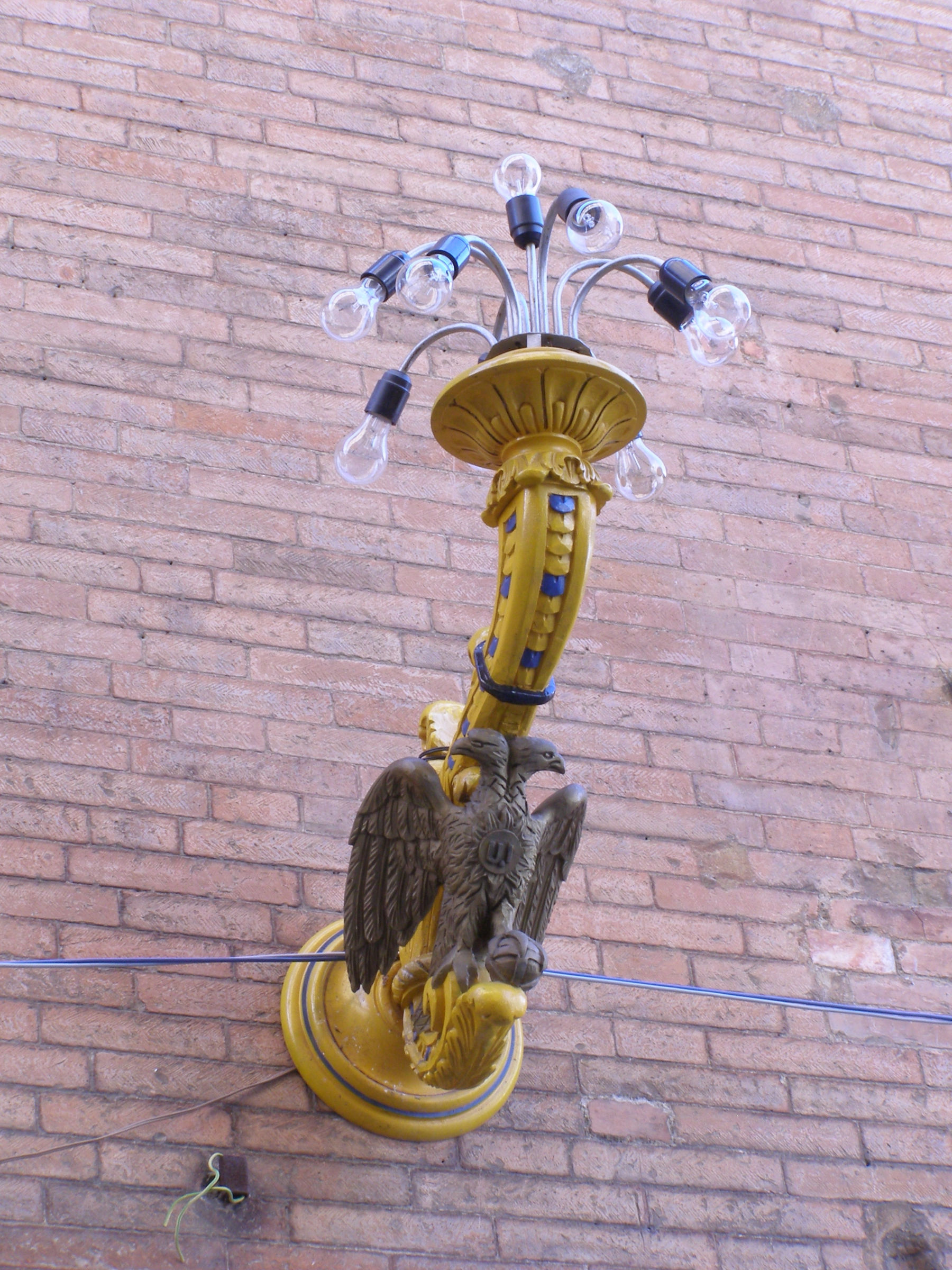
Caterpillar - Noble Contrada of the Caterpillar
The coat of arms, gold, depicts a caterpillar crowned in the grand ducal manner resting on a green twig, embellished with a rosebud. Quartered red and silver with a framed cross, the main colors are yellow and green with turquoise lists. The caterpillar is reminiscent of the silk and wool workers who inhabited the Coste d'Ovile. The district received the title of Noble for having supported the Monte del Popolo in 1371 and for the valor shown by its militia in the clash at the Cross of the Travaglio against Charles IV of Bohemia in 1369.
The baptismal font, inaugurated in 1978 in front of the summit of the Vicolo degli Orbachi, was made by Lorenzo Borgogni. Inside is a sculpture by Angelo Canevari depicting Barbicone, the legendary chieftain of the Bruco. Moreover, among the streets of the district, it is still possible to glimpse some high reliefs depicting the animal. The contrada del Bruco also has its own museum, where objects dating back to the 17th century are collected, including sacred furnishings, flags, costumes, the drapes of the won Palii, archival documents and numerous testimonies of contrada life.
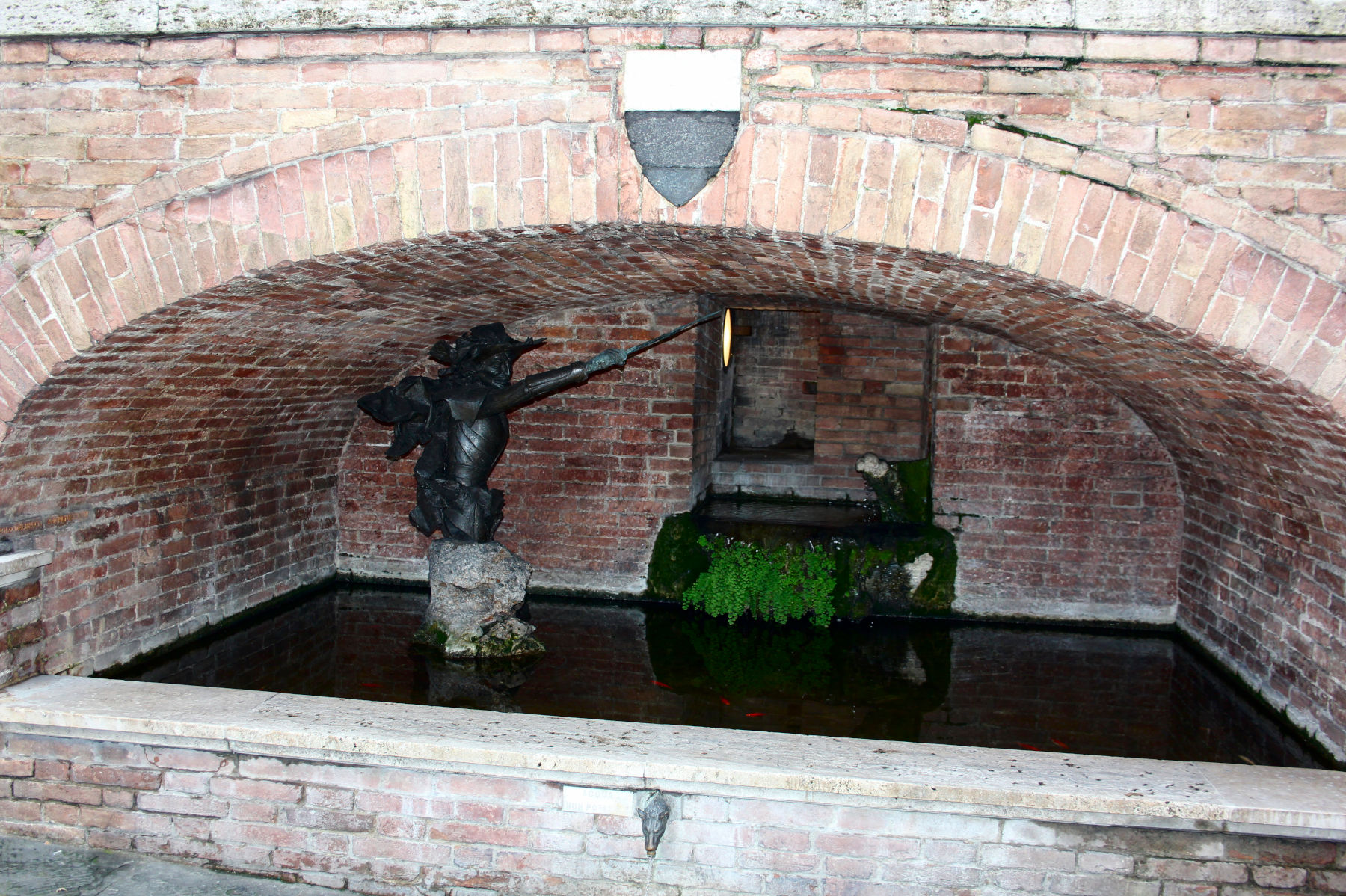

Chiocciola - Contrada of the Snail.
The coat of arms, silver, depicts a natural snail studded with the initials U and M (Umberto I and Margherita di Savoia), interspersed with red roses. The colors of the coat of arms are red and yellow with turquoise lists. The Chiocciola is the first contrada mentioned with the present name, mentioned in the 15th century by the Sienese novelist Gentile Sermini during his description of the game of pugna "Ecco la schiera della Chiocciola. Ponetel down; chi'l volere portare se'l porti...." Even at that time, the inhabitants of the San Marco district were identified with the symbol; in 1482, as Sigismondo Tizio recounts, they built a large wooden snail that ten young men carried around the city, giving the impression that it moved on its own. In 1546, during a hunt, the ward again set up a snail-shaped machine, accompanied by 62 young men dressed in the colors red and yellow. Notable events include the 1650 bufalata in honor of the princes of Tuscany, with a float depicting Scylla transformed into a rock, and the Palio of July 2, 1717, in which Apollo placed the Chiocciola among the signs of the zodiac after seeing her on a laurel leaf, recalling Daphne's metamorphosis.
The baptismal fountain, the first installed in 1947, is the work of sculptor Fulvio Corsini; on the base it bears the augural inscription "Quando alla Chiocciola vittoria arriderà / questa fontana buon vino gettare." The contrada also owns the Museum of Sacred Furnishings and Vestments, inaugurated on June 25, 1981 in the former monastery of St. Paul. Inside, wooden cases made by the workshops of artist Bernardino Barbetti house objects accumulated over the centuries, many bearing symbols and colors of the Chiocciola. There is also no shortage of singular and rare objects: a frog from 1661 used during Holy Week, a key ring from 1799 bearing the colors of the contrada, a 19th-century box for the accatto delle anime del Purgatorio (taking of the souls in Purgatory), and a small bell from 1691 from the primitive oratory of San Marco. The room also preserves numerous missals, candlesticks, reliquaries and cartegloria between the 17th and 19th centuries. In the center is a rare 17th-century gilded wooden lectern with symbols of the four evangelists and the coat of arms of the Snail. On the ceiling are wooden coats of arms of the ancient protective families of the contrada, originally kept in the church.
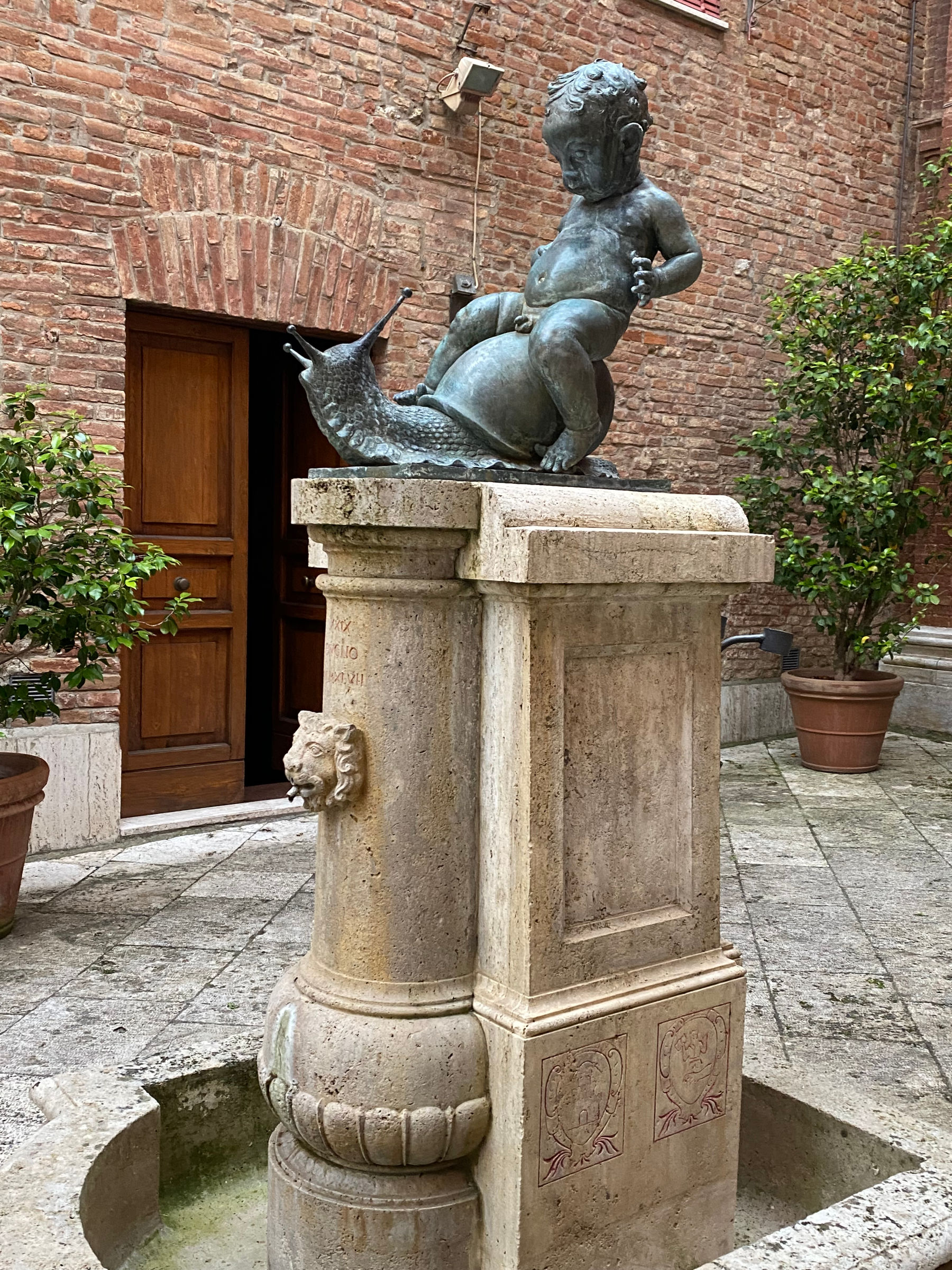
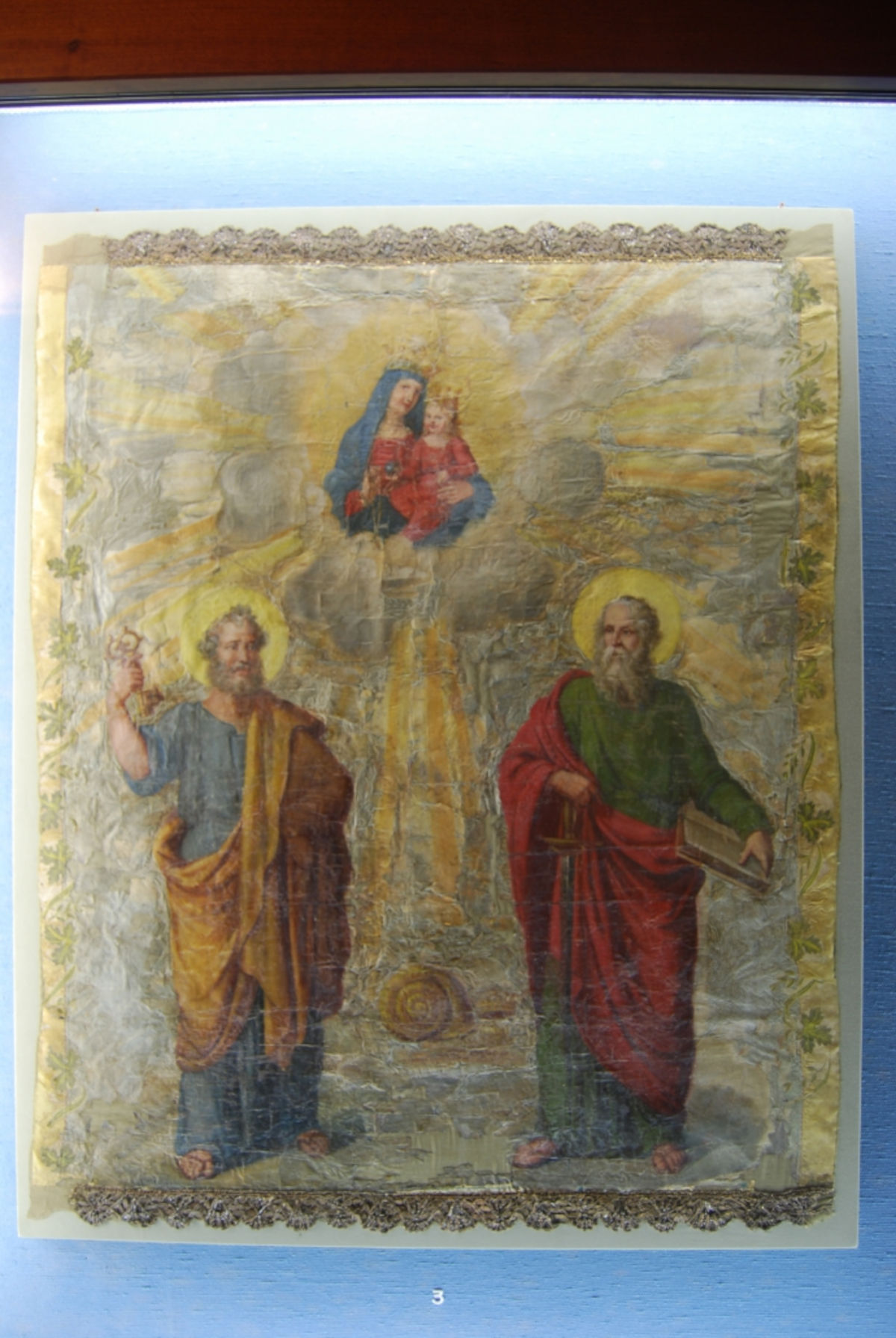
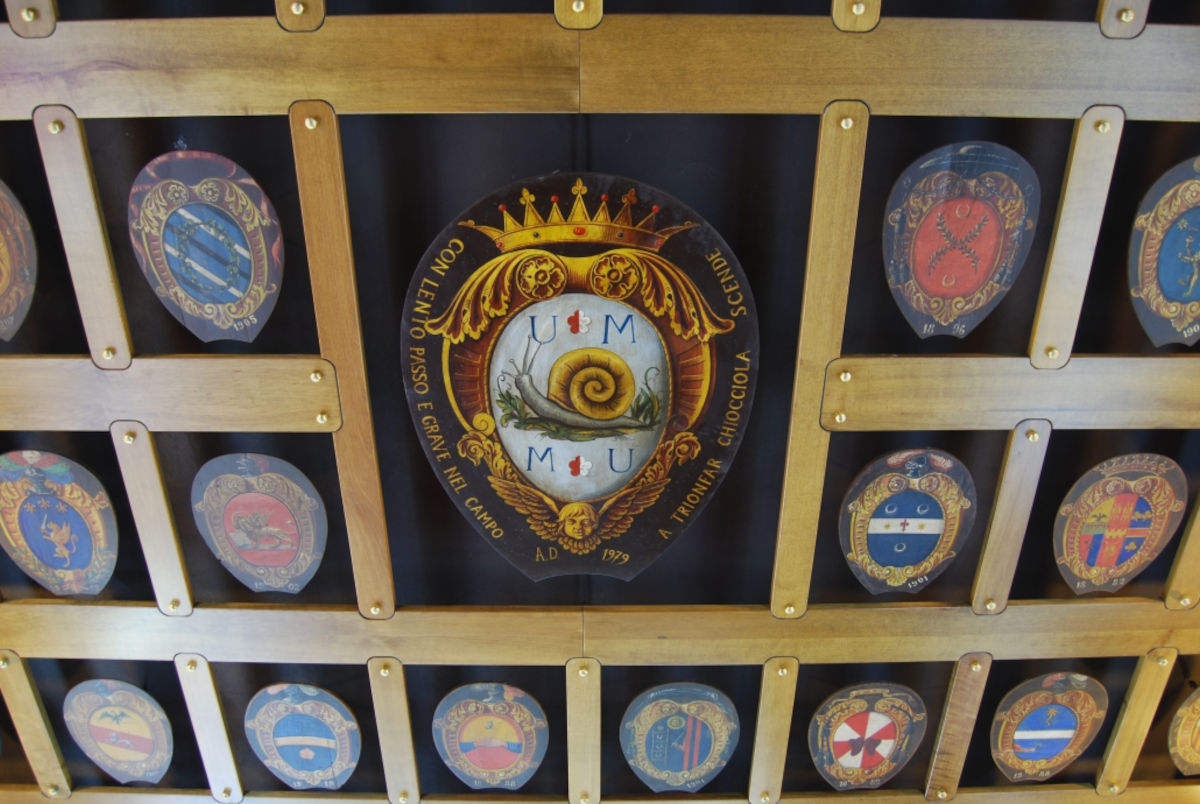
Owl - Contrada Prioress of the Owl.
The coat of arms, party in black and red, depicts an owl in majesty with two light blue shields bearing the letters U and M (Umberto I and Margherita di Savoia). The main colors of the coat of arms are black and red with white lists. La Civetta holds the title of Priora for hosting the first meeting of the Magistrato delle contrade, the body that gathers the Priors of the seventeen contrade to deliberate on matters of common interest.
The contrada museum preserves frescoes from the second half of the 20th century and sculptures by Sienese artists, along with relics, mementos, trophies and drapes won, as well as masgalani, or silver plates that at each edition of the palio are awarded to the contrada deemed the best, for elegance and poise, in the historical procession. There are also ancient and modern mounts and other relevant objects from contrada life. An integral part of the complex are the ward oratory and the stable. The baptismal font, a 2005 work by sculptor Fabio Belleschi, is located in the Castellare degli Ugurgieri and is the focal point for the baptism of new contradaioli. The owl also appears on a carriage painted with the coats of arms of the contrade of Siena, with the Eagle on the left and the Owl on the right, kept in the Santa Maria della Scala Museum Complex.
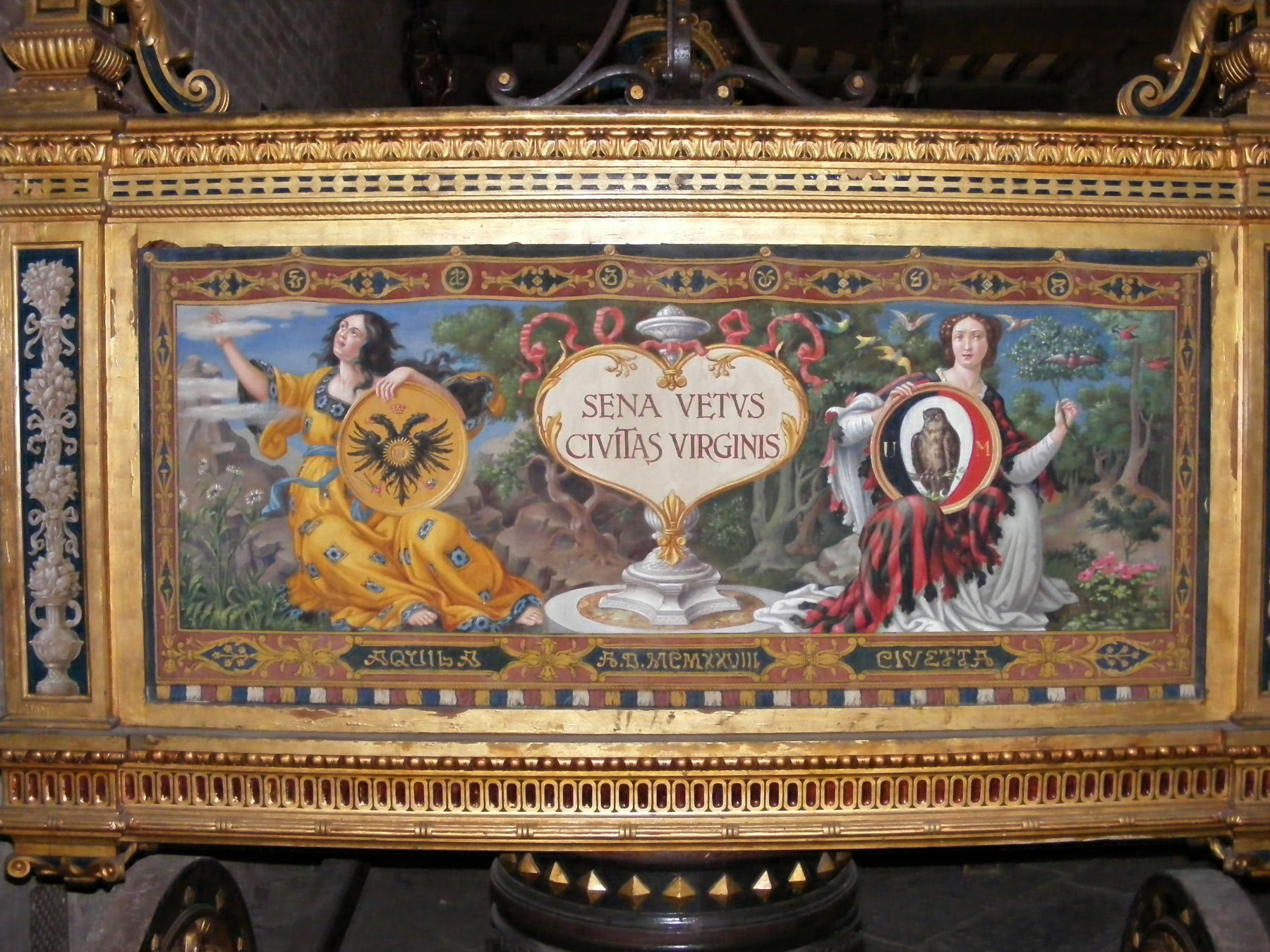
Drago - Contrada del Drago
The coat of arms, in silver, depicts an unfolded green dragon, crowned in the ancient manner and bearing an azure pennant with the initial U in gold (Umberto I), surmounted by a royal crown. The contrada of the Dragon figures among the first to appear in Piazza del Campo in public festivals. Along with Giraffa, Chiocciola and Onda, it participated in a pugna in honor of the Cardinal of Saint-Malo on March 1, 1494, but recent research attests to its existence as early as 1481, beyond public events. The insignia and name probably derive from the mythological animal in the coat of arms of the first Company; other scholars believe possible origins from the noble arms of the Borghesi or from the Benincasa family, linked to St. Catherine, Patroness of the Contrada. The Contrada took part in the first Bull Hunts with a machine in the shape of a dragon, earning the nickname "men of the Dragon." The ward's museum itinerary takes in several buildings close to each other: from the Oratory, the contrada's church, we move on to the Hall of Victories, where all the drapes conquered over the centuries are displayed.
The baptismal drinking fountain, the work of Vico Consorti from 1977, is located in Piazza Matteotti in front of the headquarters and bears the inscription, "Contrada's love for the art of Vico Consorti entrusts the memory of the great Priors Mario Calamati and Alberto Rossi to the Dragaioli who will be born." The water from the fountain is used every year during the Festa Titolare to baptize the new Dragaioli. The image of the dragon also appears on a medallion at the entrance to the church of Santa Caterina del Paradiso, corner of Piazza Matteotti and Via del Paradiso.
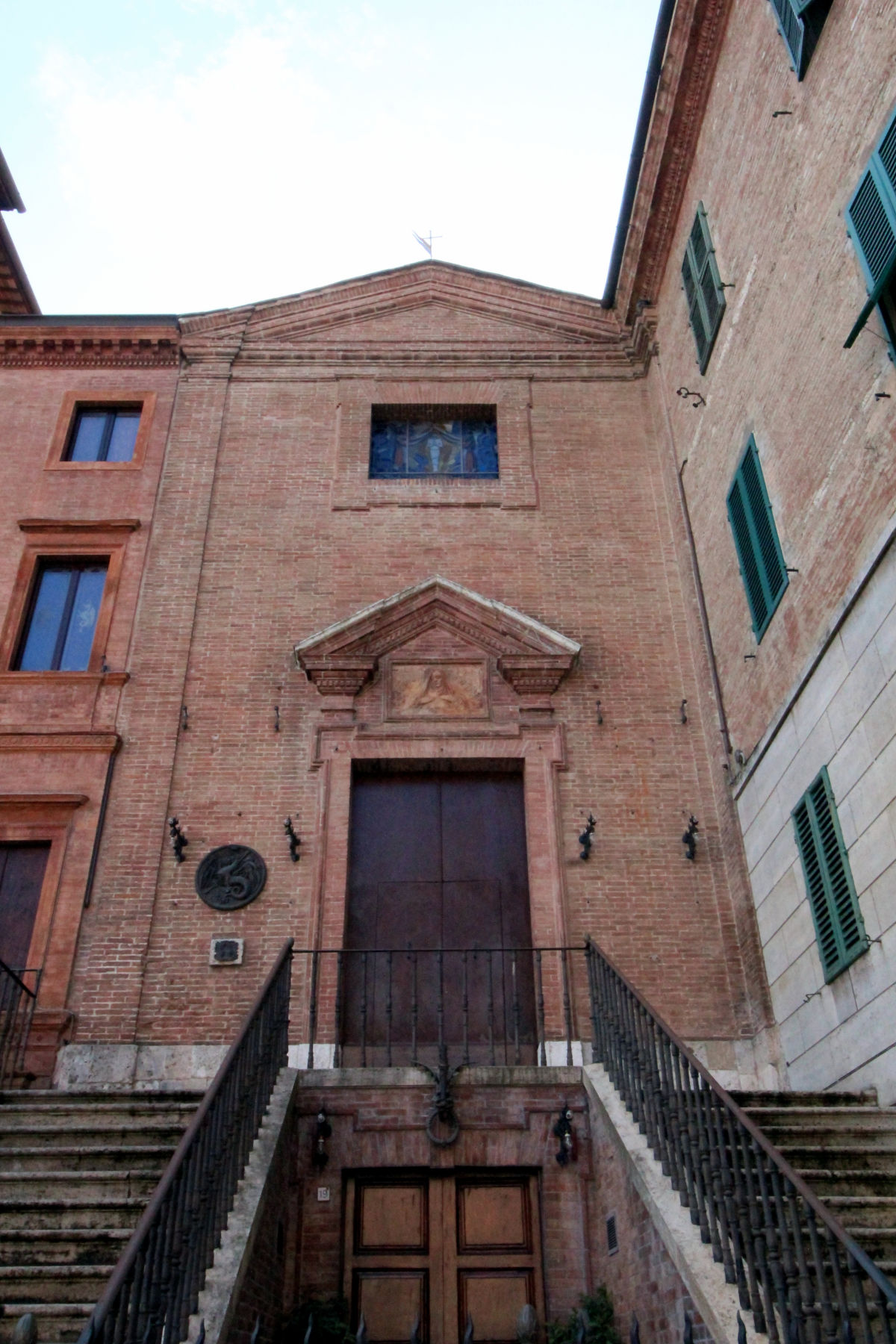
Giraffe - Imperial Contrada of the Giraffe
The coat of arms, silver, depicts a giraffe supported by a Moor dressed in the Turkish style, under a blue ribbon bearing the motto UMBERTUS I DEDIT. The colors are red and white. Giraffe is one of the first contrade mentioned with the present name: it already appears in Gentile Sermini's novelle relating to the Gioco delle pugna, around 1424, along with Chiocciola. It also appears in an August 20, 1458 letter from Francesco Sforza's chancellor to the governors of Siena. In 1482, Giraffa and Chiocciola paraded through the streets of the city as a sign of joy at the return of the Reformers to government.
The contrada museum collects over time the palii won, memorabilia, historical documents and serves as a meeting place. The spaces include the Oratory, the Hall of Victories and a connecting room, renovated in 2007, organized on two levels with a staircase that creates a perspective effect and gives lightness to the environment. On the upper floor, the display cases along the walls are interrupted in front of the arched opening, allowing the view of the Hall of Victories, where the contrada's palii are kept in special display cases. The baptismal font, by Salvatore Bocci with a bronze by Pier Luigi Olla, is located in Piazzetta della Giraffa.
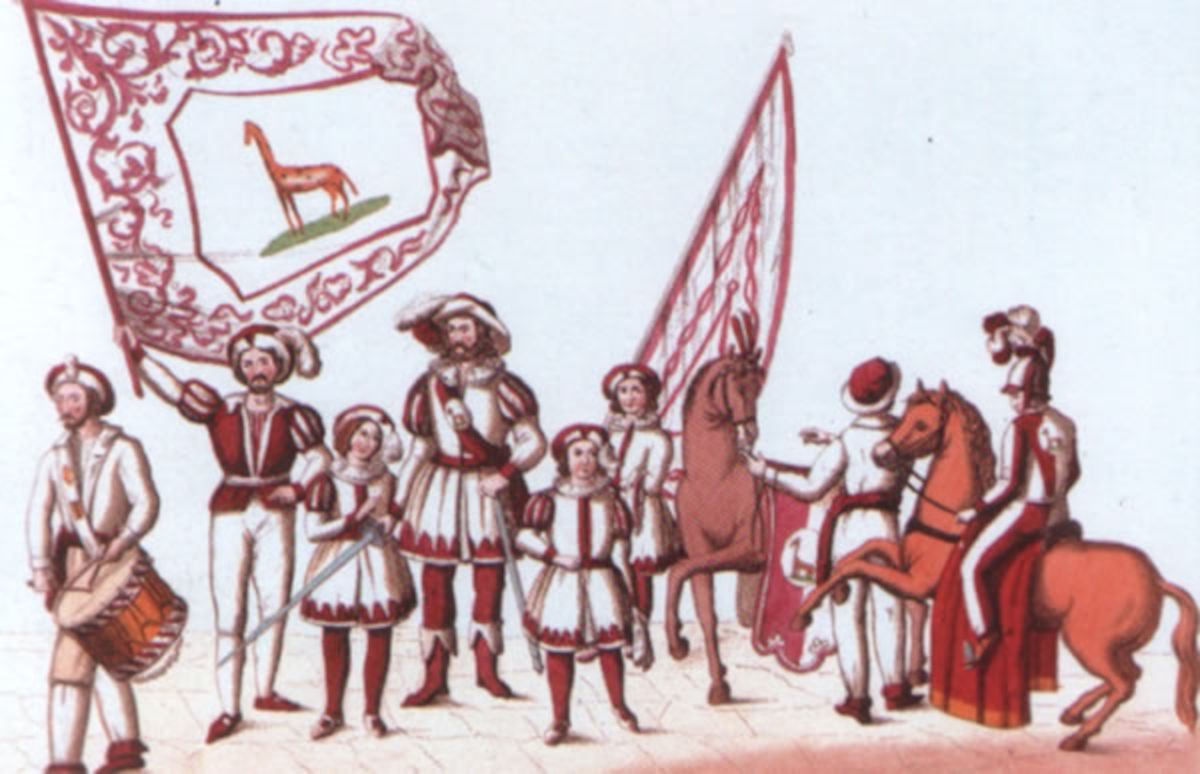
Porcupine - Sovereign Contrada of the Porcupine.
The coat of arms, in silver, shows an armed porcupine on a grassy base, crowned in the ancient style and decorated with two red Cyprus roses, a blue Savoy knot and the octagonal cross of the Sovereign Military Order of Malta in silver on a red field. The contrada received the title of Sovereign in 1980 from the Sovereign Military Order of Malta, which had been based in the Camollia district since the 14th century. The Istrice is twinned with the city of Perugia. The baptismal font, made by Vico Consorti in 1962 and located on Via Malta, bears the Contrada motto "Sol per difesa io pungo." The animal also appears on an iron in theOratory of Saints Vincent and Athanasius.
By its very nature, the Contrada Museum of the Porcupine is eclectic. Within it coexist objects that differ in age and type, transforming it into a treasure chest of memories belonging to the contrada family. Many of the artifacts on display are donations from the contradaioli themselves, centuries-old testaments to their affection and dedication to their community.

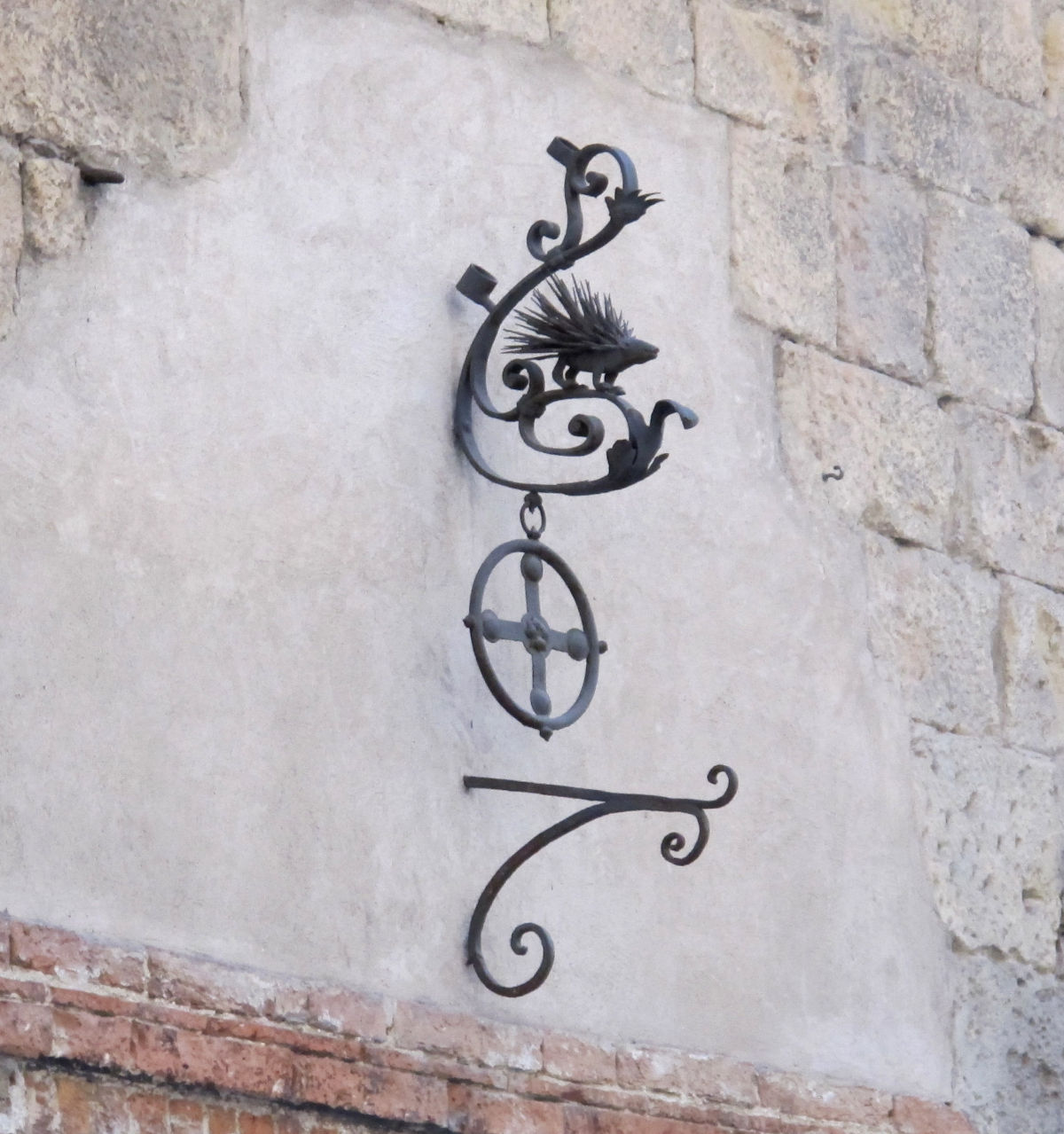
Leocorno - Leocorno Contrada.
The coat of arms, silver, shows a leocorno raised on a grassy base. The blue border bears the motto in gold HUMBERTI REGIS GRATIA. The colors of the contrada are white and orange with blue lists. The contrada's historic headquarters houses a small bell that, according to popular tradition, came from the Florentine carroccio captured at Montaperti in 1260. The baptismal font, designed by architect Carlo Nepi in 1997, is located in Via Pantaneto. Its history dates back to 1457, when, after repeated requests to the General Council of the Republic of Siena, it was built to provide water for the inhabitants of Pantaneto. Originally, according to the plan engraved by Francesco Vanni in the 16th century, it appeared as a simple masonry niche, later adorned with a marble sculpture depicting the head of an old woman, hence the name "Fonte della vecchia di Pantaneto."
Between the eighteenth and nineteenth centuries, numerous renovations altered its appearance: in 1807 architect Agostino Belli created a neoclassical design with a central archway on a Doric colonnade and a raised basin decorated with a sculptural group depicting Neptune and four tritons, the work of Antonio Zini. Damage caused by daily use led to a new restoration in 1866 by engineer Girolamo Tarducci, who simplified the structure in favor of functionality, sacrificing some of the original elegance. In 1997 the contrada del Leocorno, led by prior Lorenzo Bassi, commissioned architect Carlo Nepi to restore the fountain, restoring its prestige and elegance. The artist Francesco Carone sculpted two bronze spouts in the shape of a leocorn's head, permanently transforming the structure into the modern Fonte del Leocorno, with two functioning pools and a strong symbolic value for the contrada. Recently the green space of the district has been revitalized by the Valley of Unicorns project, signed by Daniel Spoerri, becoming a place of culture, beauty and sociality, and where today three leocorn skulls made by the artist can be admired.


She-wolf - Contrada of the She-wolf
The coat of arms, silver, depicts a Roman she-wolf bigemina on a grassy bell, crowned in the old-fashioned manner, with a silver and red border charged with red and silver crosses. The contrada colors are black and white with orange lists. The baptismal font, designed by architect Giovanni Barsacchi in 1962 and placed outside the Church of San Rocco in Vallerozzi, features a bronze she-wolf by Emilio Montagnani.
Like all the other contrade, the Lupa contrada has its own museum, which illustrates the history of the Lupa and preserves the buildings and sacred furnishings of the Compagnia di San Rocco, which merged into the contrada at the end of the 18th century. Re-equipped and reopened to the public in April 2002, the museum includes the hall of representation, the archives and the monture room. Several Lupa are scattered throughout Siena's districts. A few examples? The column with the She-wolf in Piazza di Postierla, next to the Aquila fountain; the Sienese She-wolf on a column in the Banchi di Sopra, near the Tolomei palace; the inlay in the Duomo, depicting the Sienese She-wolf and the Allied cities; and the She-wolf found in Piazza Duomo.
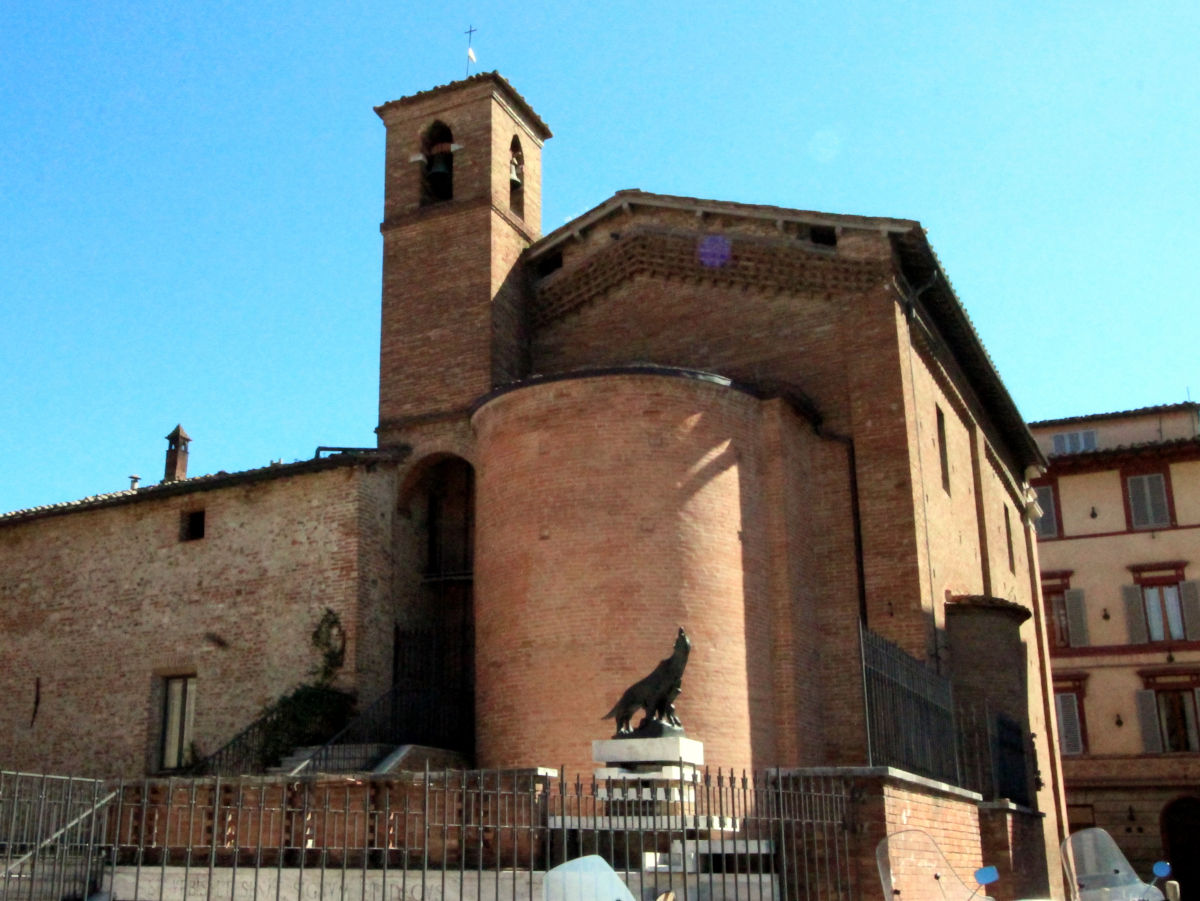
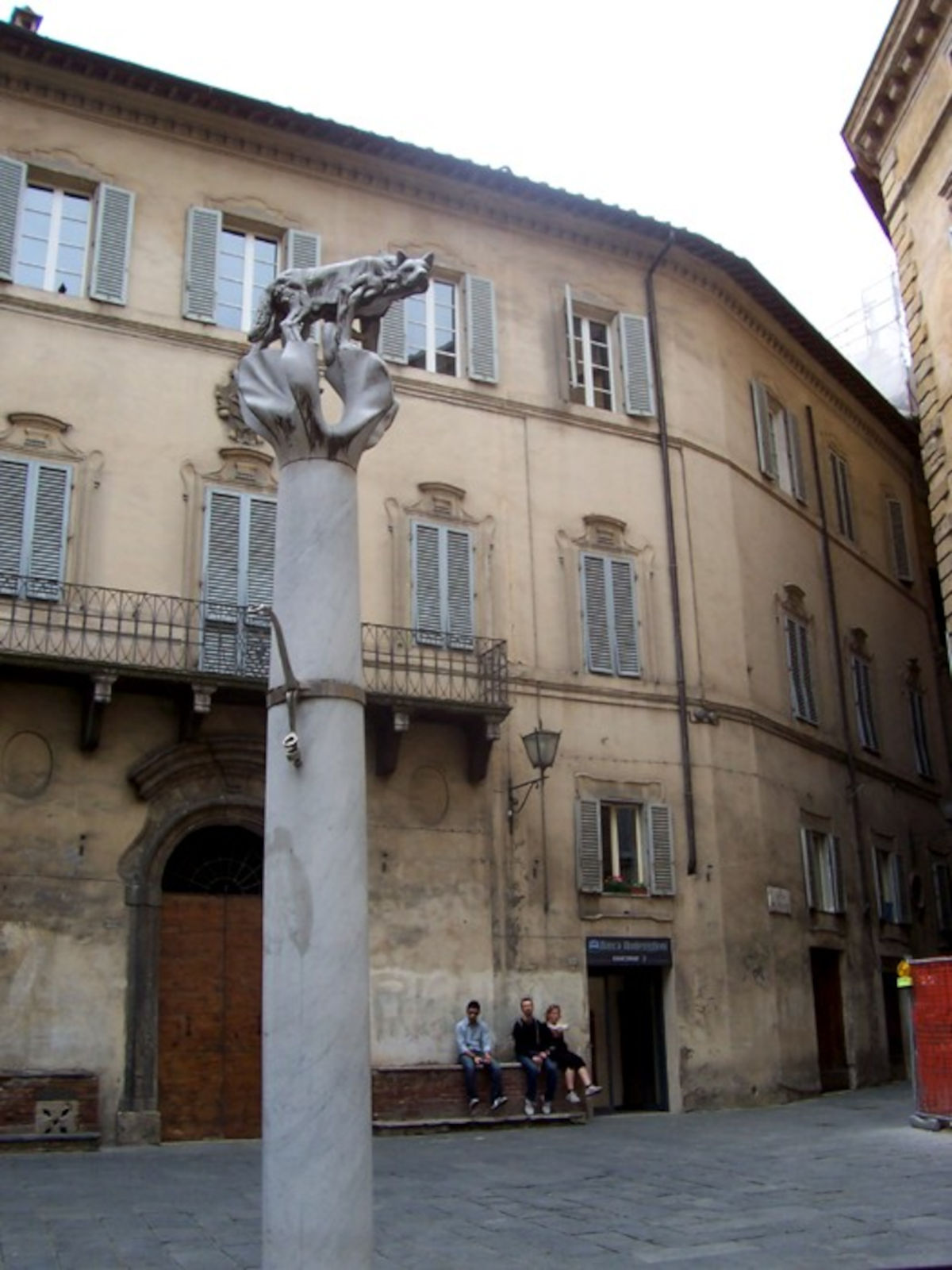
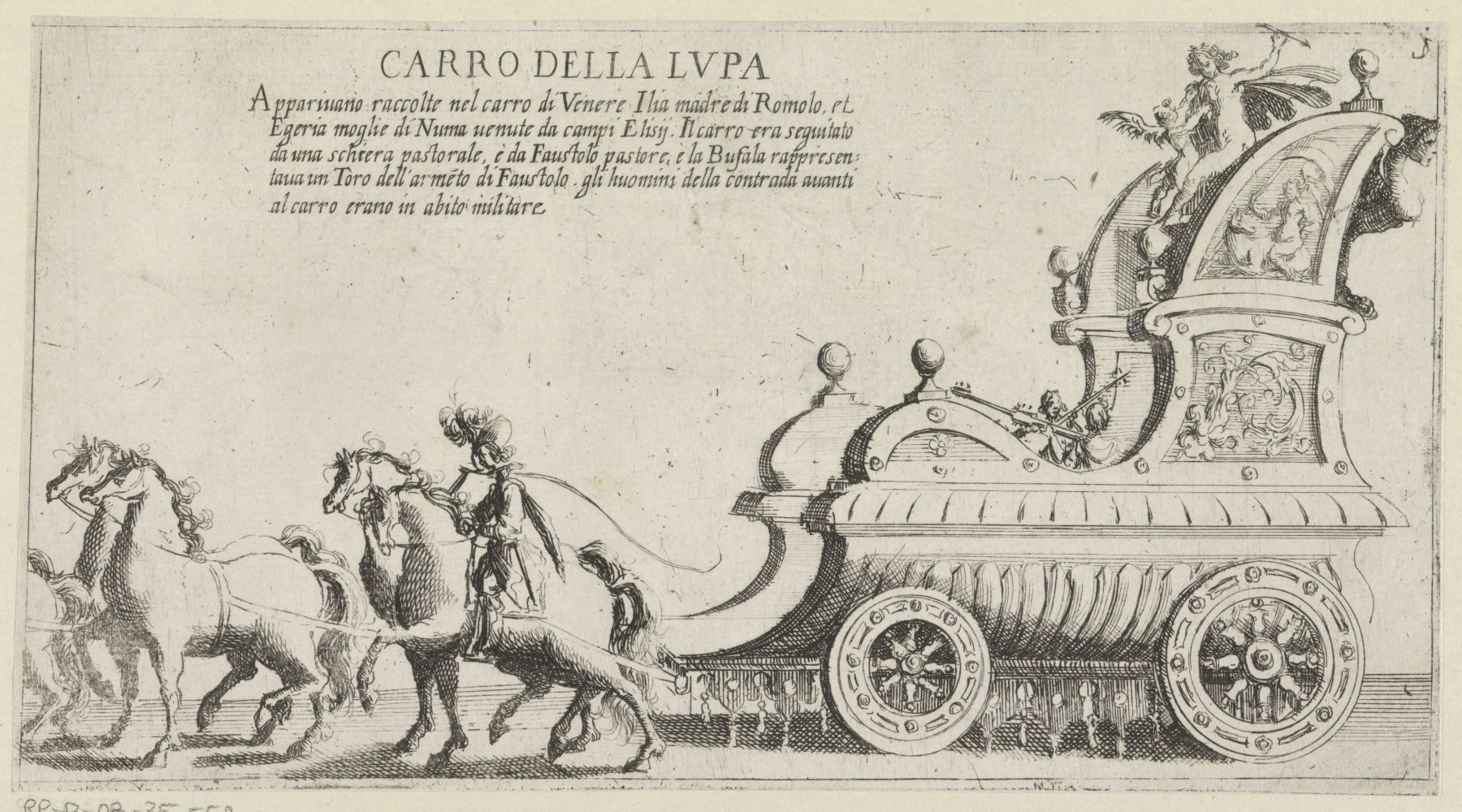
Shell - Noble Contrada of the Nicchio
The coat of arms, azure, depicts a silver shell crowned in the grand ducal style, accompanied by two branches of red coral, three knots of Savoy and two rosettes of Cyprus, one red and one silver. The colors of the contrada are azure with yellow and red stripes. The territory of the contrada del Nicchio is among the newest in the urban fabric of Siena, being located outside the city walls built in the late 12th and early 13th centuries.
The district began to develop in the early 13th century in the area between the church of San Giorgio and the "poggio Farolfi," where the convent complex of Santo Spirito would later rise, along the artery connecting Siena and Arezzo, today's Via dei Pispini. The baptismal font, known as Fonte dei Pispini, dates back to the 16th century and is located on Via dei Pispini.

Goose - Noble Contrada of the Goose.
The coat of arms, in gold, depicts a royal crownedgoose on turf, with a blue ribbon around its neck bearing the cross of Savoy. The colors of the contrada are white and green with red stripes. The contrada museum and Oratory are located in buildings of significant historical and architectural value and collect palii, silverware, paintings, drawings and objects related to contrada life and the Palio. The Hall of Victories and the museum preserve palii of great historical and artistic value, including the fifteenth extraordinary Palio of the twentieth century, run on September 21, 1969 on the occasion of man's landing on the moon, known as the "Palio of the Moon."
Non-traditional Pal ios include the Roman-style Palio (late 19th century), in which the Oca took part, winning two editions, on August 17, 1890 and August 17, 1891. Unique in the history of the Palio were the Surprise Palios of August 17, 1909 and August 17, 1919, won by the Oca: they were held the day after the ordinary Palio with random drawing of horses and jockeys. The traditional Palios include works by international artists, such as Ernesto Treccani (August 16, 1977) and Jean-Michel Folon (July 2, 1999), while Alessandro Grazi's July 2, 2007 Palio is painted on both sides, almost like two united Palios. The baptism of the new contradaioli takes place at the Fontebranda fountains (12th-13th centuries) along the street of the same name. The goose also appears in an effigy placed on the walls ofthe Oratory of the Contrada of Santa Caterina in Fontebranda, Via Santa Caterina, Siena.
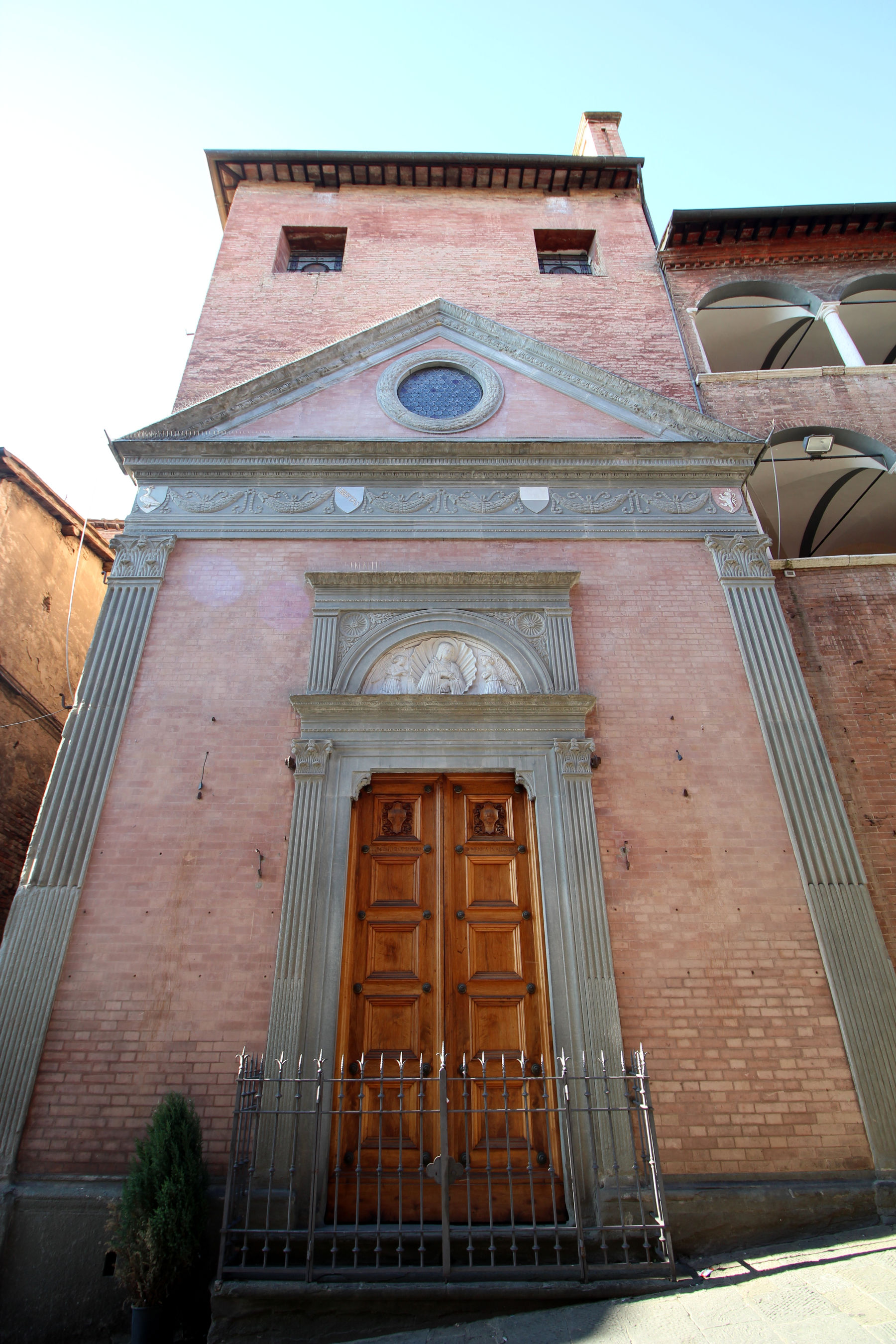

Dolphin - Contrada Capitana dell'Onda
The coat of arms, silver, depicts a crowned dolphin at the royal, swimming in the azure sea. The colors of the contrada are white and light blue. The contrada holds the title of Capitana because its militia guarded the City Hall. The wave's origins date back to the 15th century, deriving from the aggregation of the ancient military companies of Casato di Sotto and San Salvadore, with red flags with a diagonal yellow band and three red eight-pointed stars, and black and white wave, respectively. The companies' duties included garrisoning the Tyrrhenian coast of the Republic of Siena, with main port at Talamone. This is probably where the emblem of the dolphin swimming among the waves originated, confirmed by a machine presented in 1494 at a Gioco delle pugna, according to Allegretto Allegretti's Diari. The name Onda could refer to the sea or, according to Giovanni Antonio Pecci, to the sinuous course of the streets of the Contrada. Other studies connect the dolphin and waves to the Company of San Salvadore and the symbolic meaning of the fish as an allegory of Christ.
The baptismal font, designed by Algero Rosi with coats of arms by Vittorio Conti and dolphin bronzes by Alfonso Buoninsegni from 1972, is located in front of the Oratory at the beginning of Fontanella Street. The contrada's museum, MOND, is developed in the center of the district, encompassing the Crypt of St. Joseph, the original core of the museum venue, and the additional spaces of the former Policarpo Bandini kindergarten, offering an innovative itinerary le merges history, tradition and ondaiola culture.
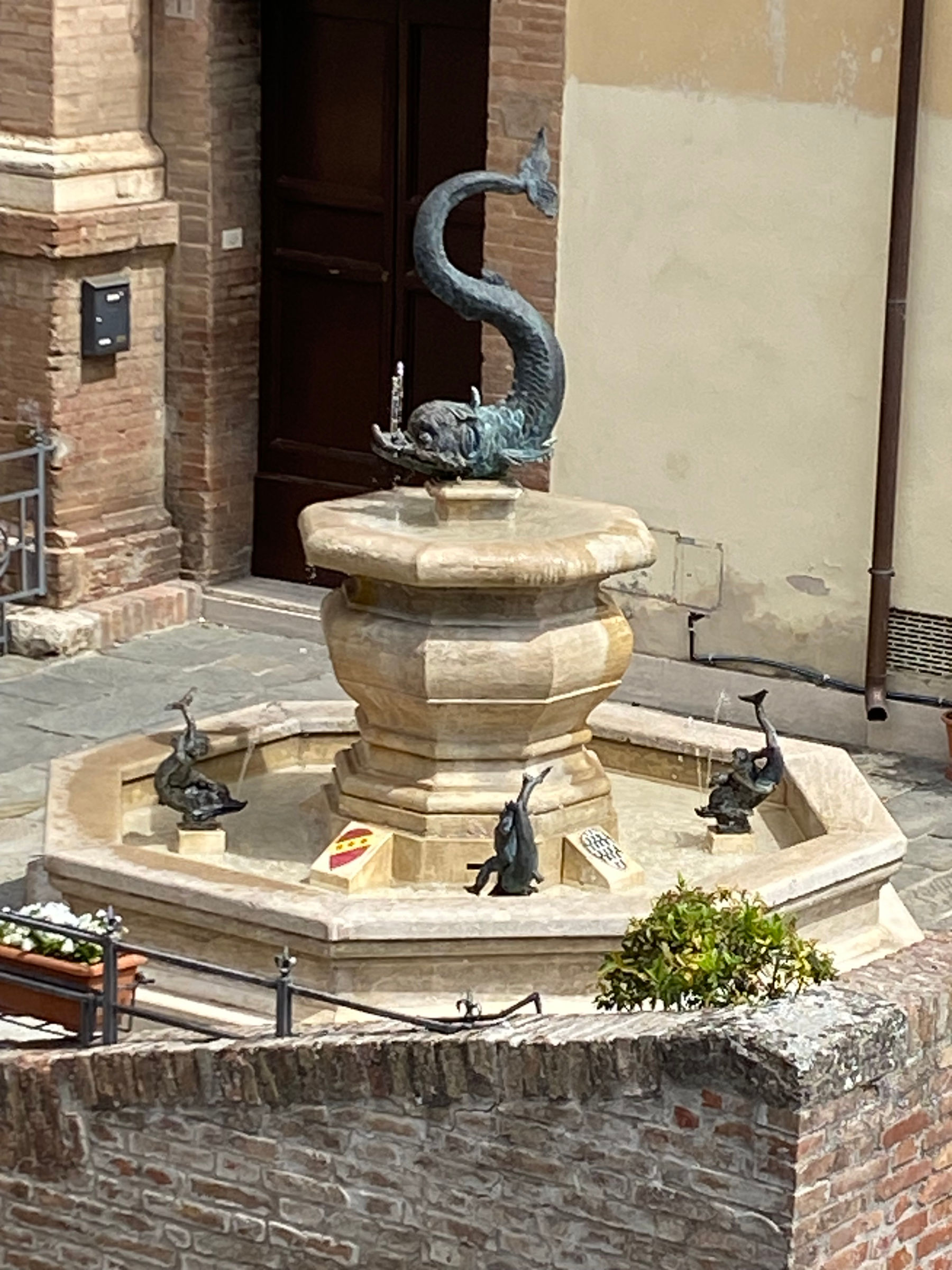
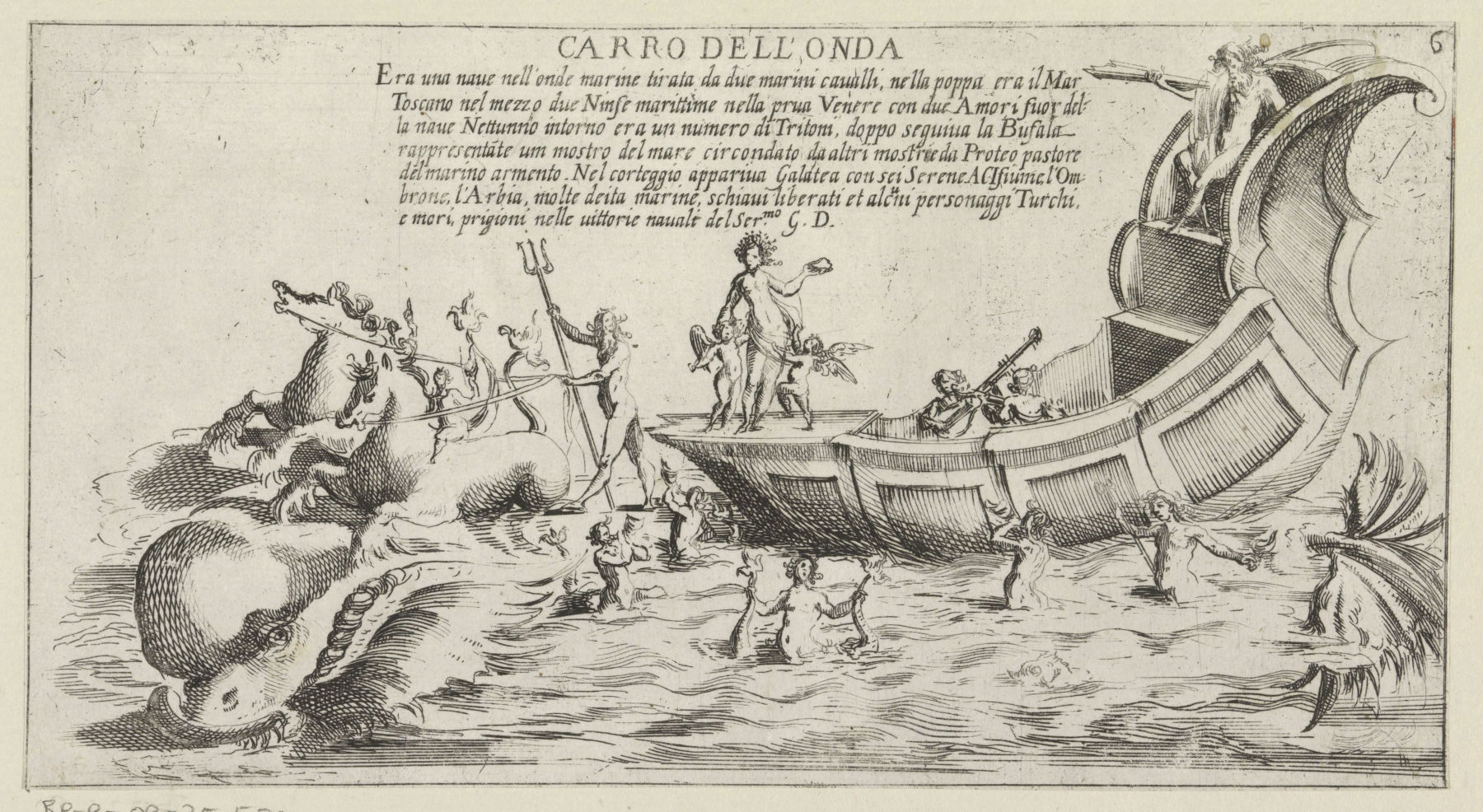
Panther - Contrada of the Panther
The coat of arms, silver, shows a rampant panther, with a white and blue quarter bearing the initial U (Umberto I) in the upper left corner. The Contrada colors are red and light blue with white lists. The Contrada of the Panther was probably born during the 1541 celebration of the marriage between Lorenzo Mariscotti and Cassandra Petrucci, an event that sanctioned peace between two historically conflicting families. Originally the Mariscotti coat of arms contained two eagles and two illeopard lions: the leopard was then granted to the new contrada, giving rise to the Pantera coat of arms, first recorded in the August 15, 1546 bull hunt.
The baptismal font, made of bronze by sculptor Giulio Corsini in 1977 on a travertine base, bears the contrada's motto and is located in Count's Square. Prominent among the works preserved among the streets of the district is the Tabernacle of Piazzetta delle Due Porte (late 13th-early 14th century), with a Madonna and Child Enthroned, a central fragment of a larger composition. The Panther also houses the Tabernacle of Via Stalloreggi (first half of the 16th century) and the Tabernacle of the Madonna del Corvo, depicting the dead Christ on his mother's lap. The Contrada Museum documents the history of the district and preserves draperies, two important wooden altar suits and archival documents from 1684 onward. In the Sala delle Vittorie also, the floor houses a mosaic depicting the Rampant Panther created in 1958 by Giordano Bruno Berrettini, while in the background is Antonio Nasini 's canvas depicting the Beheading of St. John the Baptist, the contrada's patron saint, commissioned in 1684 for the high altar of the ancient oratory in Via Paolo Mascagni. The room displays the palii won from 1904 to 2006, illustrating the artistic evolution of the drappellone in the 20th century, from the earliest examples in Sienese Art Nouveau and Purism to the modern drappellone of 1991 painted by Spaniard Eduardo Arrojo.
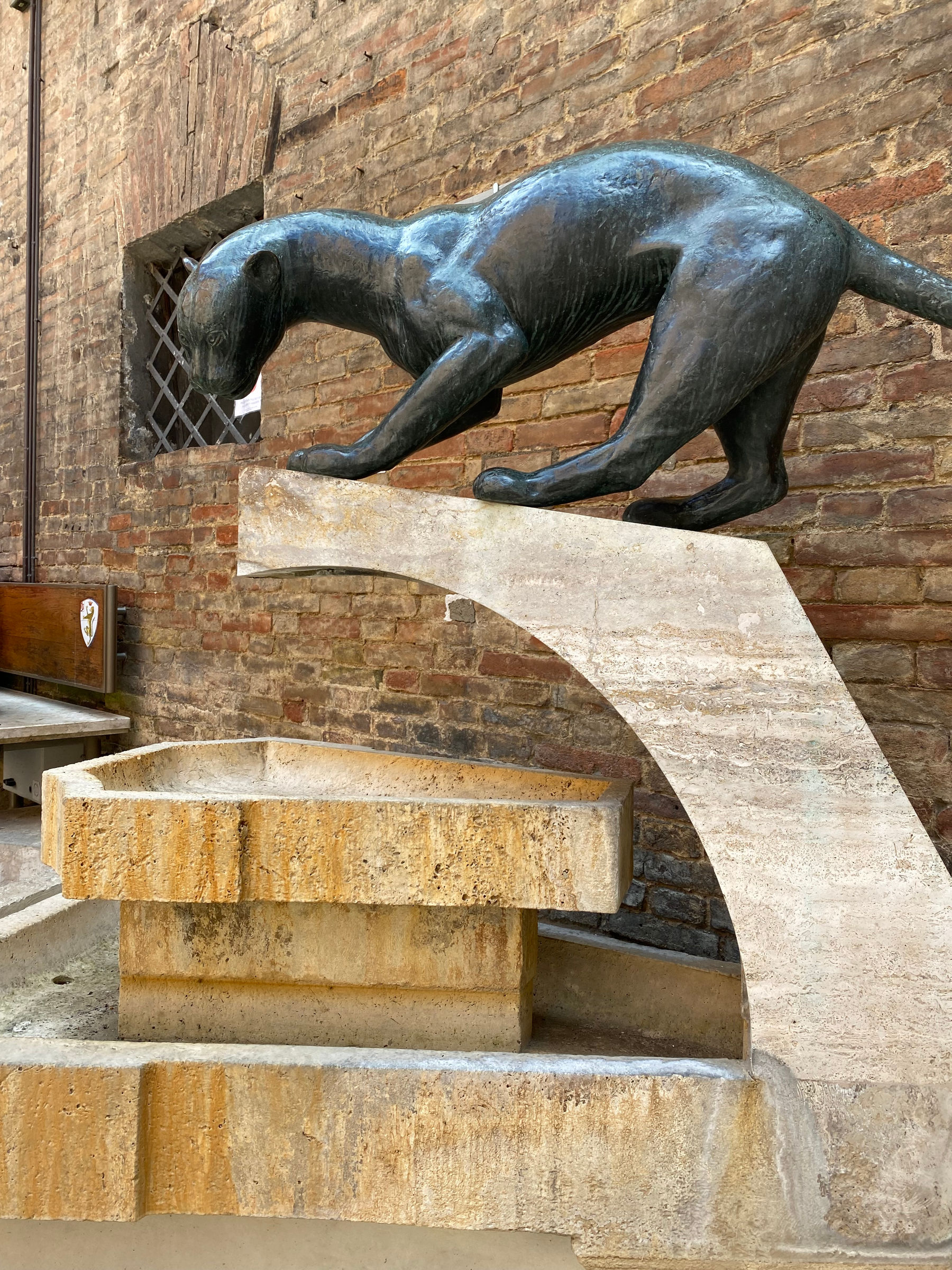
Rhinoceros - Contrada of the Forest.
The coat of arms, silver, depicts a rhinoceros at the foot of a leafy oak tree, the trunk of which is adorned with hunting trophies and surmounted by a radiant golden sun bearing the initial U (Umberto I) on a blue field. The colors of the contrada are green and orange with white lists. The motto is "Prima Selvalta in Campo," symbolizing power. The baptismal font, made by Vinicio Guastatori in 1965, is surmounted by a rhinoceros and bears the contrada's motto and is located in Piazza della Selva, in front of the headquarters.
The contrada della Selva museum is located in the crypt premises of theOratory of St. Sebastian in Vallepiatta and collects civil, religious and paliesque records of the historic contrada. A Rhinoceros statue, created by Carlo Sassi in 2000, is also located in the garden of the Selva Museum.
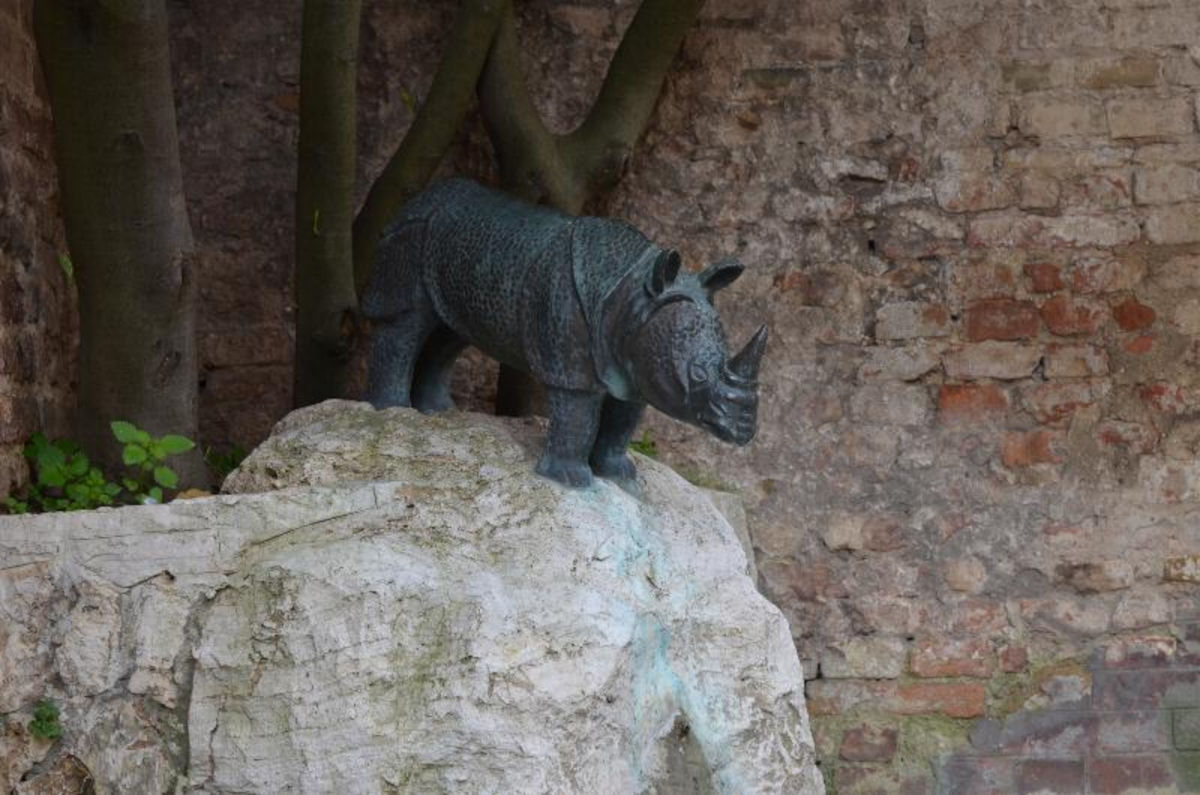
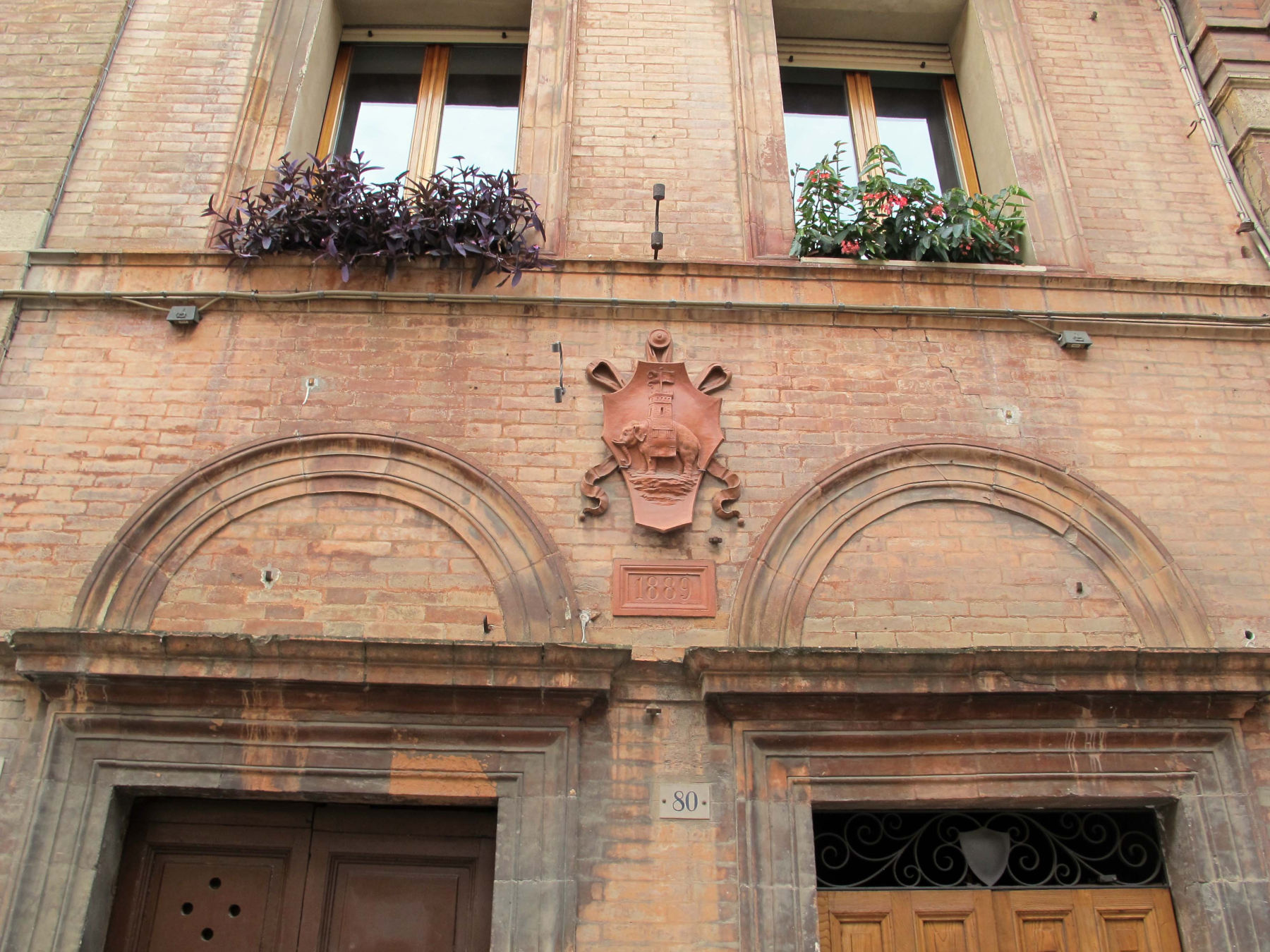
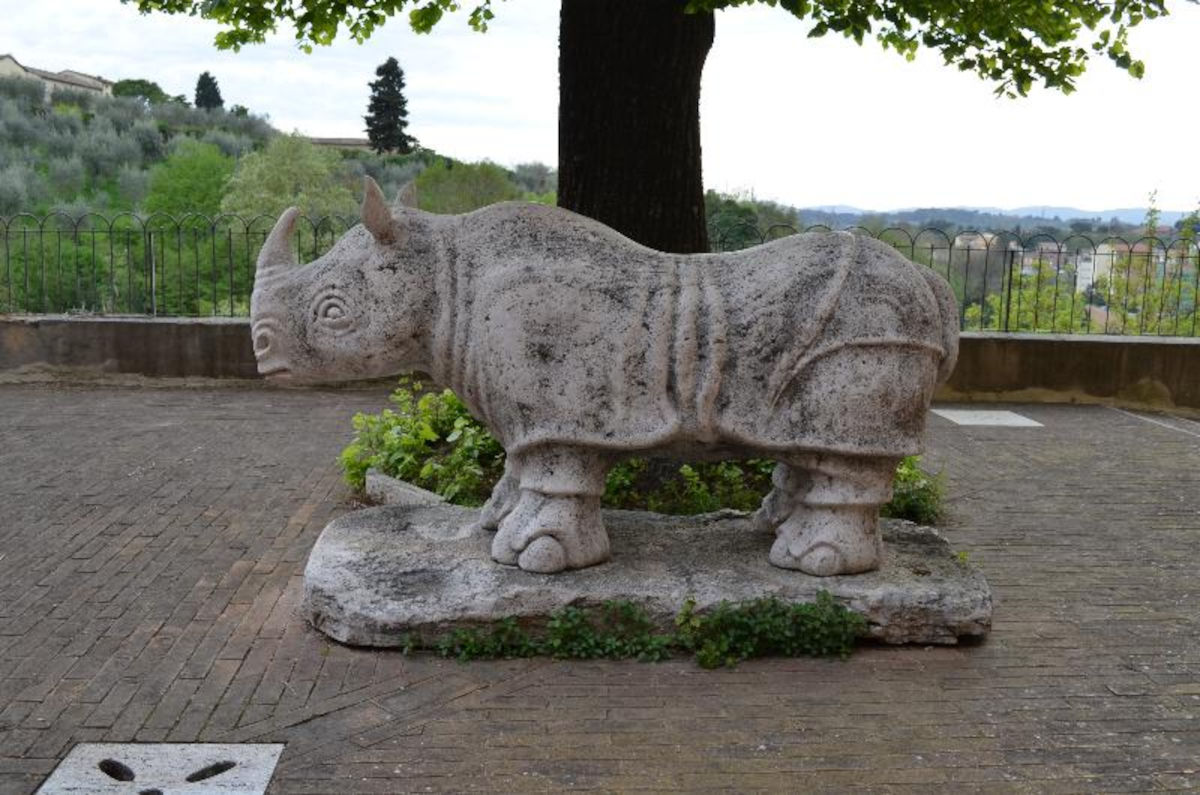
Tortoise - Contrada della Tartuca
The coat of arms, in gold, depicts a tortoise on a golden field sown with blue Savoy knots alternating with daisies. The colors of the contrada are yellow and turquoise. The motto is "Strength and constancy hotel," symbolizing steadfastness.
The Tartuca originates from the inhabitants of the district of Castelvecchio, one of the oldest areas of the city, probably of Etruscan origin. The contrada was formally formed in 1516 with the merger of the urban Military Company of Porta all'Arco and the suburban one of Sant'Agata. In fact, as early as the 15th and 16th centuries the inhabitants of the area participated in bull hunts and bufalate under the aegis of a tortoise-shaped machine with a yellow and black insignia, achieving numerous victories, including the 1617 bufalata in Piazza del Campo. The baptismal fountain with the animal sculpture, created by sculptor Bruno Buracchini in 1951, is located on Tommaso Pendola Street.


Elephant - Contrada of the Tower
The coat of arms, in gold, depicts an elephant on a grassy base with a red caparison bearing a white cross and a girdled tower surmounted by a silver crusading red pennant. The colors of the contrada are crimson red with blue and white stripes. The motto is "Beyond strength, power," symbolizing strength. The current baptismal font, byMarioBerrettini in 1984, replaces Fausto Corsini 's 1954 font. It bears the motto and inscription "VICTORIA"and is located on Salicotto Street, where there is also a terracotta coat of arms of the contrada.
The Tower Museum is located in one of the most attractive places in the district. The premises preserve architectural elements that testify to different eras, from the Etruscan era to the Roman and medieval periods, with traces of the 13th-century city walls, a 1st-century AD cistern and a Renaissance granary pit. On display are sacred vestments and liturgical furnishings from the Oratory of San Giacomo Maggiore, including two altar frontals made of fine fabric and the historic 1532 bronze bell modeled by Antonio da Siena, obtained by melting metal from Florentine cannons after the victory of the Battle of Camollia (July 25, 1526). The bell bears the image of the Immaculate Virgin and the coat of arms of the Tower. Among the most outstanding works is the pictorial panel painting by Giovanni Antonio Bazzi, known as Sodoma, made in 1546, depicting The Going of Christ to Calvary.
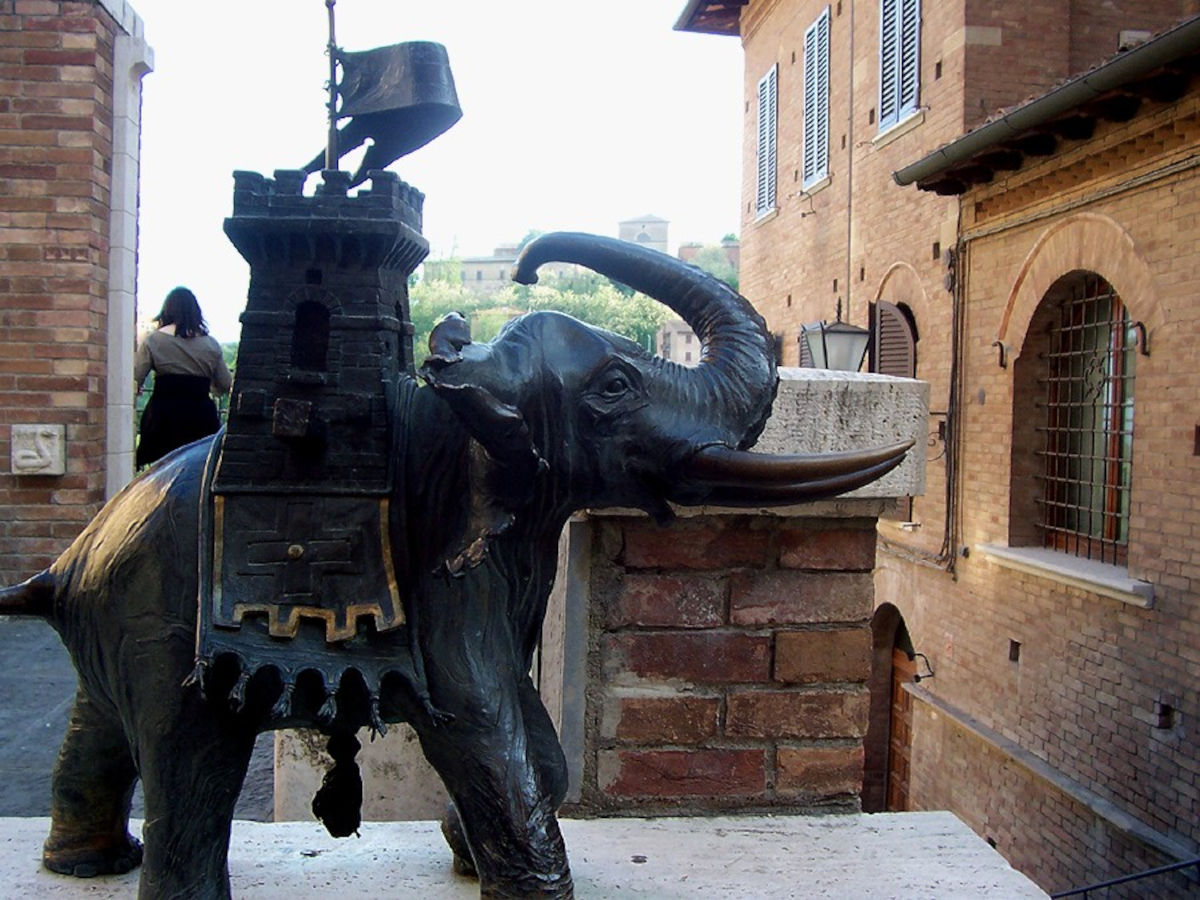
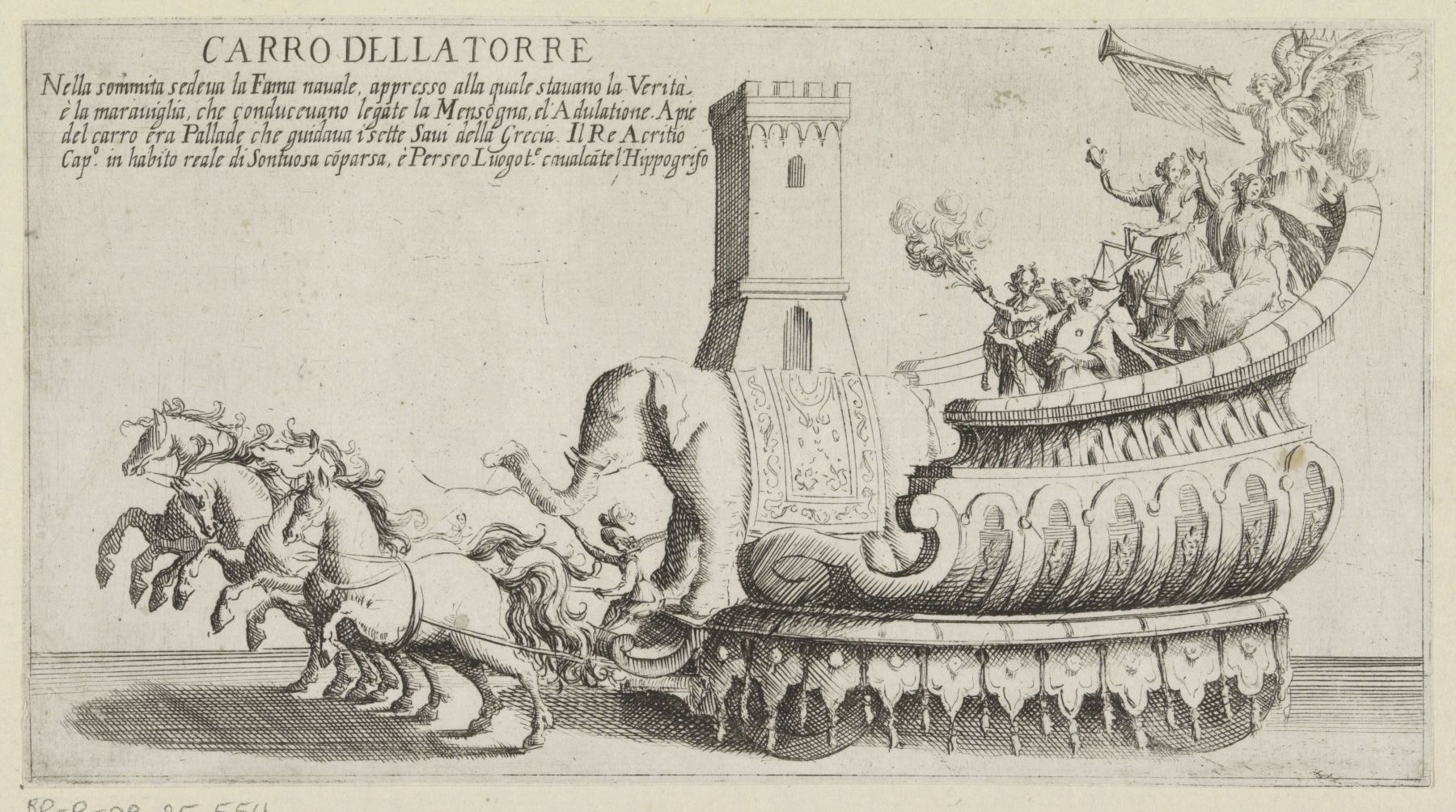
Montone - Contrada of Valdimontone
The coat of arms, in gold, depicts a rampant ram in the natural state crowned in the ancient style. In the upper left corner appears the golden letter U (Umberto I) crowned in the royal style on a blue field. The colors of the contrada are red and yellow with white lists. The motto is "Under my stroke the wall collapses," symbolizing perseverance. Valdimontone is the oldest contrada of the Terzo di San Martino and brings together the Ancient Sienese State Military Companies of Borgo Santa Maria, San Maurizio and Sant'Angelo a Montone.
Contrada baptism takes place in the Oratory during the titular feast, where the initiation of new members is celebrated in the Fontanina battesimale, a symbol of the contrada and its tradition. Also inside theOratory of the Holy Trinity is a bronze rampant ram, the work of Viareggio artist Libero Maggini. Commissioned by the Contrada of Valdimontone, the sculpture serves as a palio holder: the ram rests on a column equipped with two rings at the base, where on the occasion of victory the Palio pole is placed. The ward also features the depiction of the ram on the medallion that marks the Castelmontoro Society. In the 1970s, the contrada's growth in terms of sacred furnishings, memorabilia and number of contradaioli led to the decision to create a museum. Work began in 1978 after the land was purchased. The building today represents one of the most important examples of contemporary architecture in Siena.



